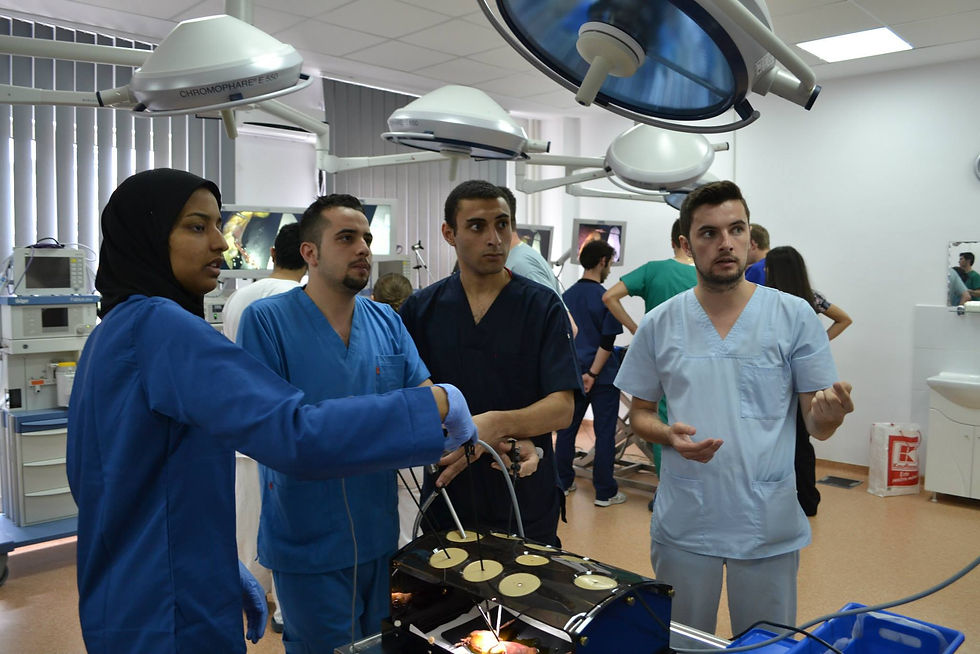 |
|---|
 |
 |
Pictures from previous courses
-
Frontal Lectures – the course will start on the 12.07.15 and will last for 4 weeks, 2 meeting/week, five hours each.
-
Study material package, the course book containing all the material needed, plus clinical quizez book.
-
Access to the course forum, online, aimed to create a joint discussion and problem solving, outside class hours.
-
Two professional seminars, blood drawing seminar (to download the syllabus of the course click here) and Basic Surgical Skills seminar (to download the syllabus of the course click here).
What do students get in the package?
The 6-year program of Medical Studies is divided into 2 main parts:
The pre-clinical stage (year 1 to 3) deals with :
Morphological sciences - anatomy and embryology, histology and pathological anatomy.
Functional Science - physiology, pathophysiology and pharmacology.
Molecular sciences - biophysics, cell biology and molecular biology, biochemistry, medical genetics and microbiology.
Once a student has studied the structure and function of the healthy body, he continues with the 5 cornerstones subjects of medicine: Internal medicine, Surgery, Pediatrics, Psychiatry and OBGYN.
The clinical stage (years 4-6) implies :
Community Medicine - epidemiology, family medicine, forensic medicine, occupational medicine and public health.
Internal Medicine - Cardiology, Gastroenterology and Hepatology, Immunology, Endocrinology, Geriatrics, Hematology, Emergency Medicine, Ophtalmology, Neurology, Nephrology, Dermatology, Rheumatology, Infectious Diseases, Angiology and diagnostic Radiology.
Surgery - General Surgery (Gastroenterology and Liver),Ooncology, Cardiovascular surgery, ENT, and Traumtology Emergency Medicine, Orthopedics, Ophthalmology, Urology, Neurosurgery and Radiology.
Pediatrics.
Gynecology and Obstetrics.
Psychiatry.
The key to success in medical school is a connection to the foundations of what has been learned in recent preclinical clinical years.
According to the French teaching school, at the transition between preclinical study to the clinical stage was a subjects called SEMIOLOGY (the study of clinical signs and Symptoms), which slowly disappeared from theworld of medicine as a profession on its own,but in fact parts of it are thought at the beginning of each clinical subject. That is, students do not get a global perspective on the theory behind clinical signs, taking a medical history and physical examination.
The unique course that we offer, Introduction to clinical medicine, offers a Global Review on the theory and practice of clinical history taking and physical examination.
The course is suitable for medical students from 2nd to 6th year, who studied the majority of the preclinical subjects and and are interested in a thorough preparation towards their clinical years - receiving in-depth overview on the most important tool of the doctor - medical interview of the patient, taking anamnesis and medical history and comprehensive system to guide the doctor to a list of differential diagnosis and finally, to reach to the correct, final clinical diagnosis.
In the course you will study the following topics:
-
The art of medical history taking and anamnesis, the importance of accuarte history review, doctor patient communication, how to approach a patiend and receiving information about the physical and mental state of the patient, by general and systemic review in the order accepted in the medial world
-
Disease vs. Syndrome – What is a disease? What are the clinical signs? What are symptoms? What is a syndrome?
-
Delivering bad news
-
Physical Examination – according to the order accepted world wide : Inspection, Palpation, Percussion and Auscultation
-
Particularities in the general physical Examination –level of conciousness, phychytricimpression, somatic type, position, reflexes, facies and their meaning, examination of the neck, cutaneous finding, hair and nail exam and subcutaneous tissue exam.
-
Introduction to Lung Diseases – The main Signs and Symptoms, Overview of the Physical Examination and Overview of the main Pulmonary syndromes
-
Introduction to the Renal Diseases- The main Signs and Symptoms, Overview of the Physical Examination and Overview of the main Renal syndromes
-
Introduction to Cardiovascular Diseases - The main Signs and Symptoms, Overview of the Physical Examination and Overview of the main CV syndromes + Introduction to ECG
-
Introduction to Gastroenterological Diseases - The main Sings and Symptoms, Overview of the Physical Examination and Overview of the main GI syndromes
-
Introduction to Blood Diseases - The main Sings and Symptoms, Overview of the Physical Examination and Overview of the main Hematological syndromes
EXCLUSIVE Keynote Lecturer! DR. Laura Poanta M.D PhD, specialist in Internal Medicine and Cardiology, Assisting Professor at the Semiology Department of University of Medicine Cluj-Napoca, Romania
The course will review in theory and practice the stages of physical examination and will prepare you in the best way for your clinical years.




Introduction to clinical medicine
Hebrew
English




